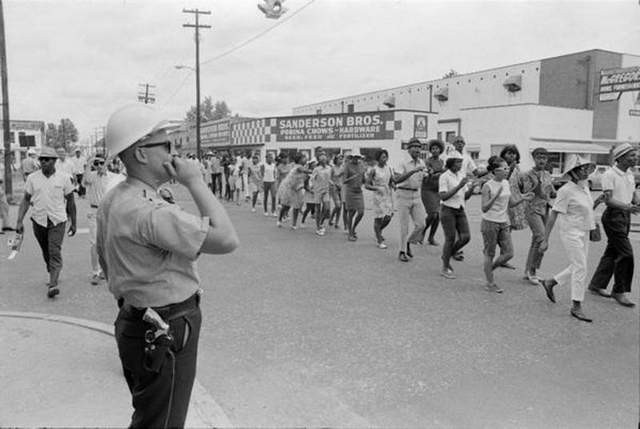Freedom House-Local Headquarters of the Mississippi Freedom Democratic Party
Introduction
Text-to-speech Audio
Images
A civil rights march in Hattiesburg, July 1967

Hattiesburg civil rights march

Backstory and Context
Text-to-speech Audio
"In 1964 the Council of Federated Organizations (COFO), which included SNCC, the Congress of Racial Equality (CORE), the Southern Christian Leadership Conference (SCLC), and the Mississippi chapters of the National Association for the Advancement of Colored People (NAACP), launched the state-wide voter registration drive known as Mississippi Freedom Summer. In Hattiesburg the headquarters of COFO, all of whose staff in Hattiesburg were the college-age men and women of SNCC, the headquarters of the Mississippi Freedom Democratic Party, and the U.S. Senate campaign headquarters of Victoria Jackson Gray were located at 507 Mobile Street. Nearby the Negro Masonic Lodge at 6th and Mobile Streets housed the Hattiesburg Ministers Union.
Freedom Summer really began with the South's first Freedom Day, January 22, in which hundreds of Forrest County African American residents, supported by out-of-state volunteers including fifty pastors from the National Council of Churches, stood all day in the rain waiting to enter the Forrest County Courthouse in order to attempt to register to vote. Demonstrations continued in front of the Courthouse throughout the Spring.
In July and August 1964, while voter registration activities continued, COFO workers, volunteers, and local residents established Freedom Schools in seven African American churches -- Bentley Chapel United Methodist Church, Morning Star Baptist Church, Mt. Zion Baptist Church, Priest Creek Missionary Baptist Church, St. John's United Methodist Church, St. Paul United Methodist Church, and Truelight Baptist Church. Mass meetings were held at these churches and at St. James Christian Methodist Episcopal Church. Church members opened their homes to the volunteers, housing and feeding them at the risk of violence and economic reprisal.
The Freedom Schools offered classes in subjects like civics and Negro history which were not taught in the Black public schools. Palmer's Crossing Freedom School students authored the "Declaration of Independence" that was adopted at the state-wide convention of Mississippi Freedom Schools held in Meridian in August 1964 and included in the platform of the Mississippi Freedom Democratic Party that same year. There were so many students enrolled in local Freedom Schools - an estimated 650-675 - that the state Freedom School director, Dr. Staughton Lynd, professor of history at Yale University, called Hattiesburg "the Mecca of the Freedom School world."
In 1964 - beginning with Freedom Day (January 22) and continuing through Freedom Summer - Mrs. Lenon E. Woods, the owner of the Woods Guest House at 507 and 509 Mobile Street, allowed the state civil rights organization the Council of Federated Organizations (COFO) to use a vacant portion of this historic two-story hotel as its headquarters for civil rights activities or Freedom House.
The building had been built between 1895 and 1900 as a hotel for African Americans in a racially segregated society. It was located in the heart of Mobile Street, the "main street" of Hattiesburg's African American community - a bustling center of small businesses, restaurants, and movie theaters, patronized not only by local African Americans but also by Black service men from nearby Camp Shelby.
Several Mobile Street businessmen and women played prominent roles in the Civil Rights Movement in Mississippi. Two of them who are alive today and who have been honored for their historic roles are Mr. J.C. Fairley and Mrs. Peggy Jean Connor. Mr. Fairley was the co-owner of Fairley's Radio and TV Repair at 522 Mobile Street and was the vigorous President of the Forrest County NAACP in the early sixties. He was responsible for the liberation of Clyde Kennard from Parchman Penitentiary, a leader in the Freedom Summer activities, and the leader of the successful 1966-1967 boycott of downtown white-owned businesses for more equitable hiring practices. Mrs. Connor was the owner of Jean's Beauty Shop at 510 Mobile Street. She served as state Executive Secretary of the MFDP and Treasurer of the Freedom Summer project in Hattiesburg.
Dr. Howard Zinn, Boston University professor and faculty advisor to the national civil rights organization the Student Nonviolent Coordinating Committee (SNCC) describes in his book SNCC: The New Abolitionists (Boston: Beacon Press, 1964) the interior of the Freedom House staffed by legendary SNCC Field Secretaries Robert Moses and Fannie Lou Hamer and furnished with the late 19th century marble-topped mahogany furniture of the Woods Guest House.
During Freedom Summer 1964, the Hattiesburg Freedom House was the bustling headquarters of the Hattiesburg and Palmer's Crossing project, the largest Freedom Summer site in the state. Under the direction of SNCC Field Secretary Sandy Leigh, over 90 volunteers and approximately 3,000 local people organized Freedom School classes for the largest number (650-675) of students in the state, voter registration instruction and canvassing of local African American neighborhoods, the refurbishing and furnishing of two buildings to serve as community centers, and the work of visiting teams of attorneys, doctors, nurses, folksingers, and the Free Southern Theater repertory troupe.
In addition to housing COFO headquarters and a Freedom Library of books donated by Americans from all over the country, the Freedom House at 507 Mobile Street also served during 1964 as the Hattiesburg headquarters of the Mississippi Freedom Democratic Party (MFDP), an alternative grass-roots political party which registered over 80,000 Black Mississippians and challenged the all-white delegation to the regular Democratic Party's Presidential nominating convention in Atlantic City in August 1964 and later the all-white Mississippi representation to the U.S. Congress. The two challenges were led by Fannie Lou Hamer from the Delta and Victoria Jackson Gray from Hattiesburg.
Victoria Jackson Gray also ran on the MFDP ticket for the U.S. Senate seat then held by Senator John Stennis. Gray's campaign headquarters were located in the Woods Guest House at 507 Mobile Street."

